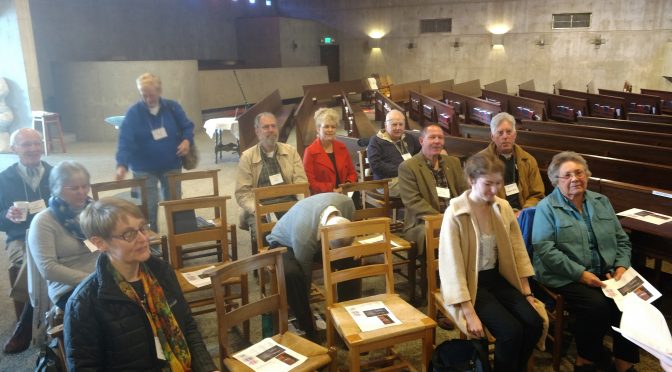Following an introduction by Tacoma AGO subdean Sheila Bristow, new Tacoma AGO member Emma Kelly opened the musical portion of the program by playing Nun freut euch, lieben Christen gmein, BWV 734. Kraig Scott’s first question to her was, “How did you decide on the tempo?”

Kraig Scott is professor of music at Walla Walla University (WWU). He has taught there since 1986 and directed the choral program since 2009. He also serves as minister of music and organist for the WWU Church and was music director at St. Paul’s Episcopal Church in Walla Walla for eighteen years. As a member of the WWU music faculty Kraig Scott’s responsibilities include conducting the University choirs, teaching organ and harpsichord, serving as church organist, and overseeing all music at the University Church.

His question on tempo led him into a discussion of how one sets the tempo in the music of J. S. Bach. In Bach’s lifetime, there were no metronomes–they were not invented until 1810, half a century after his death. Thus, there are no specific tempo markings in any of the music of Bach, or his contemporaries. There was, however, a concept of tempo ordinario, the common tempo. Common tempo typically referred to a work with a 4/4 time signature, and marked by predominant 8th notes, and maximum value of 16th notes. It is likely that the ordinary tempo was based on the human pulse.
Emma Kelly gave good answers to the tempo question. She chose the tempo based on the acoustics of the room, and on wanting to make the cantus singable. She also happened to choose tempo ordinario.
Emma’s piece, Nun freut euch, is really a trio. The right hand has the fastest notes, and, if played by individual instruments, might be suitable for a flute. The left hand plays the cello part, and the pedal carries the cantus. In this case, the left hand, the cello part, would be the timekeeper, akin to the percussion section in a jazz band.
In performing this piece, it is important for the organist to feel the three different time pulses simultaneously. The most important is, of course, the cello part, which should reflect the feel of a cello. Likewise, the upper 16th notes should reflect the playfulness of a flute. The chorale melody, in the pedal, should sound singable.
Dr. Scott was complimentary of Emma’s playing–both in her setting of the tempo, and playing the three voices distinctively.
AGO Member Cheryl Drewes chose to play a trio sonata, the second movement of Sonata 4, BWV 528, with a tempo marking of Andante. Cheryl thinks of Andante as a walking tempo; Kraig Scott added his interpretation that Andante is a modifier to the concept of the tempo ordinario, slowing it down a bit. In this movement, 32nd notes are more prominent than 16th notes, also serving to slow the tempo. Turning his attention from tempo to articulation, Kraig discussed the inherently difficult task of performing trio sonatas, with three independent lines, all of which require independent articulation, including the pedal. Kraig asked the audience to consider how a string player would articulate the melodic line of a trio sonata. The string player would have to lift the bow to make a big leap, but would be able to play conjunction motion, motion between contiguous notes, more smoothly. Kraig advocates a similar concept for Baroque music–a relatively smooth transition for conjunct intervals, but more space in disjunct movement. It’s easy on one line, but much more difficult when playing three independent lines.

Member Satya Jaech played BWV, the Dorian Fugue. Again, the discussion began with tempo. Satya set her tempo to honor the gravitas of the piece, but to still have a feeling of movement. Kraig did not disagree, but also pointed out that the tempo Satya selected was very close to ordinary tempo even though the piece is in cut time.

Kraig used this piece to talk about the concept of relaxation. On a piano, it is necessary to apply more force to get more volume, but not so on an organ. Even when playing loud, it is important to maintain good hand position and to remain relaxed.
Following the student performances, Kraig compared two harpsichord works, pointing out that their structure is similar yet performers often choose to play them at very different tempos. The session ended with a discussion of tempo changes within a piece, and how Bach’s designations such as Adagio or Allegro affect the ordinary tempo.


